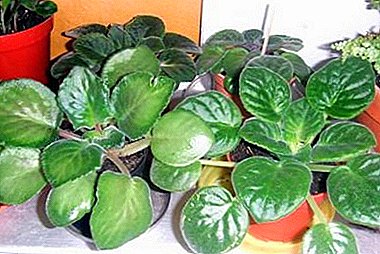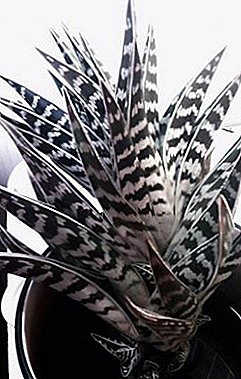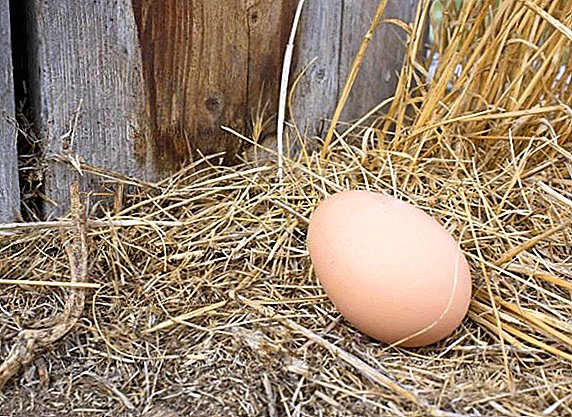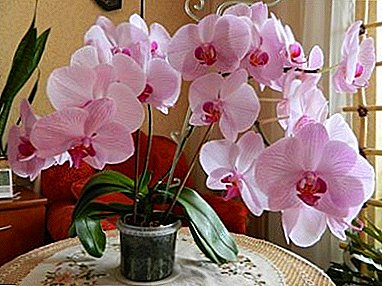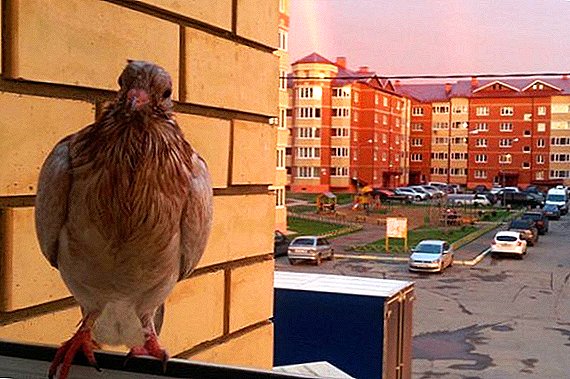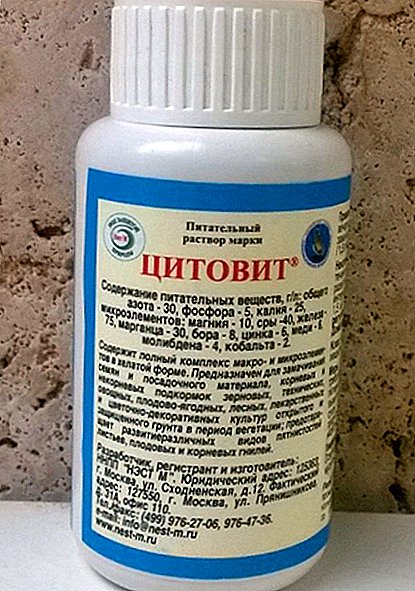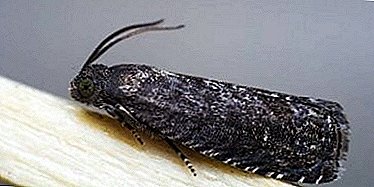
People grow gardens to admire the beauty in spring and summer, and in the fall to receive a well-deserved harvest of tasty fruits.
If pests settle in these gardens, you can lose the fruits, and even the garden itself.
Apple trees, as well as many other trees, are considered to be very dangerous enemies. The apple and eastern varieties are of the same type.
Description of Codling Moth
 Codling moth is an insect belonging to Lepidoptera family.
Codling moth is an insect belonging to Lepidoptera family.
Externally, in adulthood - a small butterfly with gray wings, the lower of which is lighter and have a frame in the form of a fluffy fringe, and the upper ones are dark ash and decorated with brown ovals on the ends with golden divorces.
Wingspan from 17 to 22 mm. They lay white flattened eggs to millimeters in diameter.
The caterpillars are flesh-colored or slightly tea-colored, cream-colored up to 2 cm long. The head and strip of the prongs of the upper part are brown. On body scattered gray warts.
The larvae have a brilliant light brown cocoon up to 1 cm in length.
East view
The eastern moth is similar to the apple-shaped wings, but smaller in size, up to 14 mm. You can recognize it by a more brown shade and seven light strips of strokes on the upper part of the wings and a weak pattern of light gray wavy patterns on the ashy wings. The reverse sides of the wings are slightly silver.
She lays eggs also smaller - up to half a millimeter. Their color is first transparent with a pearl shade, which then turns pink. The caterpillars of the eastern pinwheat, respectively, are also shorter than that of the apple tree and can be other than pink and cream milky-white. The shield near the head is dark, but is located below and not on the back of the head.
The pupa is similar to brown, but darker and with a distinctive feature: two rows of near-white spines on the body.
Stages of development
 In the spring of the surviving cocoons when reaching air temperature 15 degrees moth moths fly out.
In the spring of the surviving cocoons when reaching air temperature 15 degrees moth moths fly out.
Pupillary moth buds pupate in 2 weeks from May to early June. Then they lay eggs on the sepals of flowers, leaf surfaces and twigs.
Oriental pupae come alive a little earlier, as the first flowers bloom.
For 1-2 weeks, each female of the eastern moth lays up to 200 eggs (apple - up to 120). A week later, the caterpillars develop from them, which already in a couple of hours bite into the fruit. The caterpillars feed on the pulp of fruits (apple trees - seeds inside the fruit) for 10 to 24 days, after which they crawl out and pupate on the surface of the fruit, in the sinuses of the damaged shoots, under folded leaves. In the pupal stage, the pest is delayed from 5 to 12 days.
After this, butterflies fly again, mating, laying eggs and the activity of a new generation of pests.
NEED TO KNOW: pests are active at night. During the day, you may not even notice them.
Related species
The morphologically close view to the apple and eastern moths is Plum, which honors the blue color with the metallic tint of the back side of the wings and the orange color of the caterpillars. Also similar to the described pests and Pear moth.
They are all similar in appearance, behavior, and damage to fruit.
A photo
Visually familiar with the apple and other species of moth can be in the photo below:





Geographical distribution
The homeland of the eastern moth is considered to be China, Korea and Japan. Nowadays, the pest belongs to the species that are common in the subtropical and southern temperate zones. In the Russian Federation and on the territory of the post-Soviet space, it is found in the Astrakhan region, Stavropol and Krasnodar, North Caucasus regions, Belarus, Ukraine, Moldova, Lithuania.
In Europe, the eastern pinwort is recorded in Austria, Germany, France, Switzerland, Italy, Spain, Poland, Romania, Hungary, Bulgaria, the Czech Republic.
The codling moth also originated from the warm climate of Eurasia. And since the main factors limiting the distribution of the moth are average temperatures below + 12 °, these days they can be found almost everywhere where there are apple trees.
What is dangerous pest?
 And the eastern and apple moths - one of the most dangerous pests fruit trees. The first of them is even considered quarantine.
And the eastern and apple moths - one of the most dangerous pests fruit trees. The first of them is even considered quarantine.
That is, when importing such fruits as peaches, apricots, plums, pears, apples, cherries, cherries, an inspection and sampling for the presence of infection by these pests is necessarily carried out.
When finding them all products must be destroyed to prevent spread in the area. The danger is in the high speed of reproduction of the codling moths and their polyphagnosity (multinality).
Caterpillars of the first generation Oriental moth moth can develop before the fruit in the branches and young shoots. Gnawed on 10 - 15 cm, the plants crack and gradually die.
Caterpillars of the codling moth fly out a little later and spoil the fruit, gnawing at them the moves and leaving traces of vital activity all the way, thus making the spoiled apples. But those and other larvae bark of trees and basal areas are used for wintering.
So in China a record was recorded for the destruction of the pear harvest (up to 50%), and our southern regions lose 70% of quince. Peaches of late ripening varieties may not be obtained at all due to damage by the crop moths.
Prevention and struggle
 If you are faced with moths in the fall, then traps or sprays will no longer help. start prophylaxis immediately new crop next year.
If you are faced with moths in the fall, then traps or sprays will no longer help. start prophylaxis immediately new crop next year.
Dig aisle and ground pristvolnyh circles in order to destroy the caterpillars who settled there to winter.
- Carefully inspect the tree. Dead, damaged bark, infected branches and leaves need to be collected and destroyed.
- Since the larvae crawl on healthy fruit at night, it is very important to collect the fallen fruits and bury them.
IMPORTANT: The depth for utilization of fruit spoiled by the moth flake must be at least 0.5 meters.
During the growing season, the following is recommended:
- If the larvae are already deposited, and in large numbers, then you can use biological weapons against the eastern podozhorok - the entomophage called Trichogramma. The larvae of these parasites destroy the eggs and thus clean the gardens. Larvae of the species Braconid Askogaster also parasitize on eggs.
- You can install traps with odors (pheromones), which will also attract males of apple codling mounds and leave them glued to them.
- In large gardens, it makes sense to apply chemicals to the treatment of trees (Decis Pro, Calypso, Intavir, EU Match 050).
In the very first days of the release of the caterpillars from the cocoons, or even better, the first spraying is made the day before, then every 2 weeks again. So up to 5 times (on late-ripe apples).
But remember that the more chemistry, the more harm to human health.
- A more gentle way is to apply the phytoncidal properties of some other plants. So wormwood, needles, tansy, all parts of tomatoes proved effective. Decoctions and infusions of them can be sprayed trunks and branches, thereby scaring off pests.
- Attract by all means natural defenders of plants - birds. To do this, make birdhouses and feeders.
- Apply and methods of manual collection of apple podozhorok. To do this, rings of burlap are superimposed on the trunks of the trees, which are tied tightly at the top and weakly at the bottom. Caterpillars crawl below and remain in these traps.

TIP: stop using chemicals only at the beginning of the summer, long before the final ripening of apples.
For more information on how to properly deal with the codling moth, see the video below:
Conclusion
There are a lot of ways to rid your garden of pests. If you approach this wisely and use complexes of protective methods, then by autumn your efforts will certainly be rewarded a hundredfold and excellent fruits for health will both please and strengthen your health.
For more useful information about the Codling moth, see the video below:


